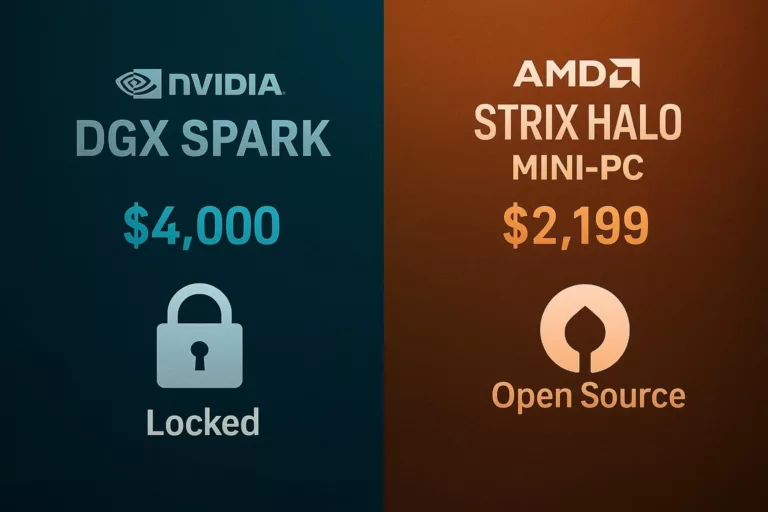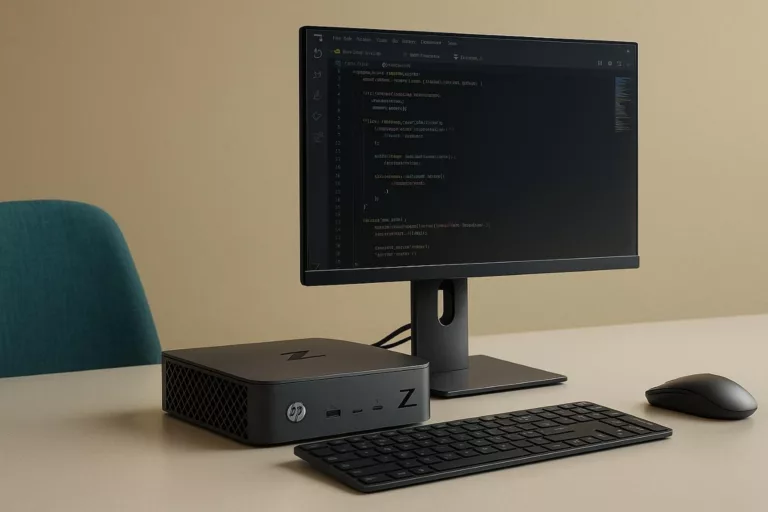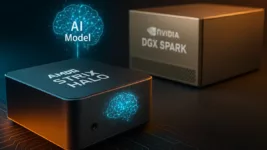Here in Bend, where we appreciate both cutting-edge tech and practical value, the AI hardware market is producing some fascinating matchups. The entire industry has been defined by NVIDIA’s “shock and awe” approach: massive GPUs and eye-watering performance claims with price tags to match. NVIDIA’s DGX Spark, a desk-side “mini-supercomputer,” is a prime example. Priced at a hefty $4,000, it’s marketed as the essential tool for serious AI developers. But a new challenger has emerged, not from a server rack, but from the compact world of mini-PCs, and it’s showcasing how AMD is delivering staggering AI performance for a fraction of the cost.
Recent benchmarks have pitted the $4,000 DGX Spark against a new $2,199 mini-PC from GMKtec, the EVO-X2, powered by AMD’s monster APU, the Strix Halo (also known as the Ryzen AI Max+ 395). The results are nothing short of a market disruption. While the DGX Spark holds its own in raw, high-throughput processing, the AMD Strix Halo system demonstrated better real-time performance, with faster token generation and lower startup latency in several key large language model (LLM) tests. This isn’t just a minor win; it’s a profound shift in the value equation for AI development.
The Power of the APU: Why Strix Halo is a Game-Changer
The NVIDIA DGX Spark is a specialized tool, a $4,000 dev kit designed to perfectly mirror NVIDIA’s enterprise-grade data center environment, right down to its proprietary CUDA software stack and advanced networking. Its value is in the entire ecosystem, not just the chip, allowing a developer to test code that will later be scaled up on massive, multi-million-dollar NVIDIA servers.
But AMD’s Strix Halo, the heart of the new mini-PCs, plays a different game. It’s an APU (Accelerated Processing Unit) that integrates a powerful CPU (Zen 5), a high-performance integrated GPU (RDNA 3.5) and a dedicated NPU (Neural Processing Unit) with 50 TOPS of AI performance all on one chip. This is all connected via a unified memory architecture, that, in the GMKtec EVO-X2, can be configured with up to 128GB of shared LPDDR5x RAM.
For a developer running models locally, this unified memory is a massive advantage. It allows them to load and run enormous 70B+ parameter models directly in memory, a feat that would normally require a much more expensive discrete GPU with a limited VRAM pool. The Strix Halo isn’t just “competing” with the DGX Spark in real-time inference; in many common developer scenarios, it’s proving to be faster and more responsive, and costs nearly half as much.

The Target Audience: Who Needs What?
This comparison highlights a critical divergence in the market. These two products, despite similar AI capabilities, are for two very different users.
- The NVIDIA DGX Spark User: This is the Enterprise Developer. Their company is already committed to a multi-million dollar NVIDIA DGX infrastructure in its data center. Their primary goal is not raw performance-per-dollar; it’s ecosystem continuity. They need a desktop-sized box that runs the exact same CUDA-based software stack as the production servers, allowing them to prototype and validate code locally before pushing it to the cloud. For them, $4,000 is the price of admission to that seamless, proprietary workflow.
- The AMD Strix Halo User: This is the Mainstream Developer, Power User or Startup. This user wants the absolute best performance for the money. They are likely using open-source tools like AMD’s ROCm, which are rapidly gaining traction. They need a machine that can both run a massive 70B parameter LLM for development and function as a high-performance workstation for video editing or even AAA gaming. The Strix Halo-based mini-PC isn’t just an AI dev kit; it’s their entire computer, offering a level of versatility the DGX Spark (which runs on an ARM processor and can’t game) simply cannot touch.
The Rise of the Compact AI Workstation
The battle between the Strix Halo and the DGX Spark is the perfect showcase for one of the most exciting trends in computing: the rise of the compact AI workstation. For the past year, AI development has been largely centralized in the cloud, costing companies a fortune. Now, hardware has advanced to the point where powerful, billion-parameter models can be run locally.This shift is democratizing AI. Small businesses, startups and individual developers can now experiment and build complex AI applications without renting expensive cloud instances. This is fueling a boom in the mini-PC market, with manufacturers like GMKtec, Minisforum, and Framework all racing to put these powerful APUs into tiny, desk-friendly boxes. These devices are the “AI PCs” that professionals actually want, offering massive memory and performance in a quiet, efficient, affordable package.

NVIDIA: Ill-Prepared for a Value-Driven Market
This new market dynamic leaves NVIDIA looking surprisingly ill-prepared. NVIDIA’s entire business model is built on selling high-margin, proprietary hardware and a locked-in software (CUDA) ecosystem. At $4,000, the DGX Spark feels like an extension of that high-margin strategy, aimed at protecting NVIDIA’s data center dominance.
NVIDIA doesn’t seem to have a good answer for the developer who doesn’t want to pay $4,000 for a dev kit, especially when a $2,200 AMD machine offers better real-time performance and plays Cyberpunk 2077 at 1080p (Strix Halo gaming benchmarks). AMD is winning the value proposition, and as the AI software world continues to embrace open-source alternatives, NVIDIA’s “CUDA-only” moat looks less like a fortress and more like a liability.
Wrapping Up
The competition between AMD’s Strix Halo and NVIDIA’s DGX Spark represents more than just a battle of specs—it’s a philosophical divide in the future of AI computing. In Bend and beyond, where performance, efficiency and practicality matter in equal measure, this face-off captures a turning point. NVIDIA’s long-standing dominance has been built on a closed, high-margin model that rewards those already inside its ecosystem. But AMD’s emergence with the Strix Halo—and the GMKtec EVO-X2 that showcases it—signals a shift toward openness, affordability and local empowerment. When a sub-$2,200 system can deliver performance on par with, or even exceeding, a $4,000 proprietary rig, it’s clear the market is evolving toward accessibility and versatility.
AMD’s approach is democratizing the AI landscape. The Strix Halo isn’t just another high-performance chip; it’s a platform that brings real AI development into the hands of students, startups and everyday creators without needing to lease cloud GPUs or buy into a locked software stack. As AI hardware becomes more compact, efficient and affordable, developers are realizing they can do more with less and own the entire process from idea to implementation. For those looking to give the gift of power and possibility this season, whether to a young coder, a small business innovator or a creative dreamer, AMD’s open-architecture advantage makes the Strix Halo platform not just a product but a statement that the future of AI belongs to everyone willing to build it.






